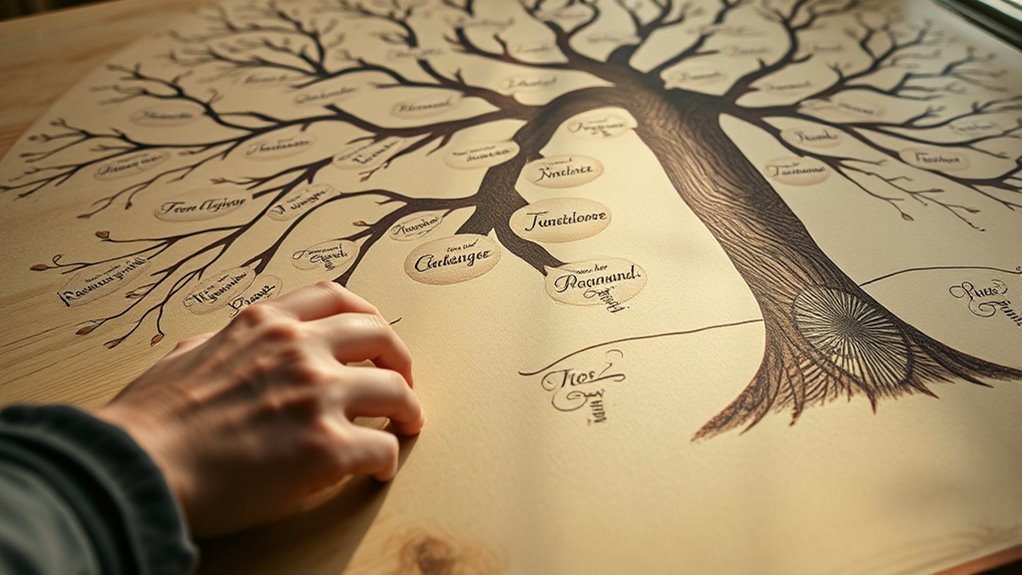Spanish naming customs feature a unique dual surname system, where you take your father’s surname first and your mother’s surname second. This reflects your family heritage and connects to both lineages. The order of these surnames is important, especially in legal contexts, as it signifies your family’s cultural identity. In informal situations, some might drop the maternal surname, but both names usually stay intact in formal settings. There’s much more to discover about these customs and their significance.
Key Takeaways
- Spanish names typically consist of a given name followed by two surnames, one from each parent, reflecting family heritage.
- The first surname is usually the father’s, while the second is derived from the mother’s lineage, indicating family connections.
- In informal contexts, some regions may drop the maternal surname, but both are retained in formal situations for legal purposes.
- The order of surnames is significant, as it denotes family lineage and must be correct for official documentation.
- Dual surnames symbolize a balance between paternal and maternal heritage, highlighting the importance of both family lines in identity.

Have you ever wondered why Spanish names often seem longer than those in other cultures? This perception comes from the unique naming customs that have developed over centuries. The history of naming conventions in Spain has shaped how people identify themselves, and you’ll find that these traditions can vary markedly across different regions. In essence, Spanish names typically consist of both a given name and two surnames, which can make them appear quite lengthy.
In Spain, the first surname usually comes from the father, while the second one is derived from the mother’s family name. This practice reflects a balance between paternal and maternal lineage, which is quite distinct from many other cultures that primarily focus on the father’s surname. This dual surname system allows for a more detailed representation of family heritage. When you meet someone with a long name, you’re likely witnessing a rich tapestry of familial connections.
Regionally, variations in surnames can add another layer of complexity. For instance, in some areas of Spain, it’s common for people to drop the maternal surname in everyday conversation, while others might retain both in formal settings. In Latin American countries, you may notice that the naming conventions have evolved from the Spanish roots, with many people using both surnames but sometimes adapting them to fit local customs. This can lead to confusion when trying to trace family histories, as names may change over generations or differ from one region to another.
Regional variations in Spanish surnames highlight cultural diversity, reflecting local customs and complicating family history tracing.
Moreover, the importance of naming order can’t be overlooked. In Spain, the order of surnames matters, as it signifies lineage. When someone introduces themselves, the order often reflects the family’s standing or preference. This practice can be vital when dealing with legal documents or official matters, as the correct order must be maintained. Additionally, understanding the significance of dual surnames can provide insights into cultural identity and family connections.
As you explore Spanish naming customs, you’ll come to appreciate the depth of cultural significance behind each name. It’s not just about identification; it’s a representation of family heritage, regional identity, and personal history. So, the next time you come across a long Spanish name, remember that it’s not just a name—it’s a story woven through generations, showcasing the beauty and complexity of Spanish culture. Understanding these customs can enrich your appreciation for the diverse world of names and the histories they carry.
Frequently Asked Questions
Can I Change My Surname to Match My Partner’s?
Yes, you can change your surname to match your partner’s. To do this, you’ll need to follow legal procedures for surname modification, which often involve filing a request with the appropriate authorities. Depending on where you live, you might need to provide documentation, such as marriage certificates. Be sure to check the specific requirements in your jurisdiction, as they can vary. Once approved, you’ll officially have your partner’s surname!
What Happens to Surnames in Same-Sex Marriages?
In same-sex marriages, both partners typically have equal rights regarding surnames. With the legal recognition of same-sex marriage, you can choose to adopt your partner’s surname or keep your own. Surname inheritance rights also apply, so children can inherit surnames from both parents, reflecting both identities. If you decide to change your surname, it’s important to follow your local regulations to guarantee everything is legally recognized.
Are There Regional Variations in Naming Customs Across Spain?
Yes, there’re regional variations in naming customs across Spain. In some areas, you’ll notice distinct regional naming traditions that reflect local culture and history. For instance, certain regions might prefer specific surnames over others, leading to regional surname preferences. These variations can influence how families choose names for their children, resulting in a rich tapestry of naming practices that celebrate Spain’s diversity while adhering to common customs.
How Do Children’s Surnames Differ in Other Spanish-Speaking Countries?
In other Spanish-speaking countries, children’s surnames often reflect cultural differences in surname inheritance and regional naming traditions. For instance, in many Latin American nations, children typically adopt both parents’ surnames, usually with the father’s surname first. However, in places like Argentina, it’s not uncommon for families to prioritize the mother’s surname. These variations highlight the rich tapestry of naming customs that exist across different Spanish-speaking cultures, each with its unique practices.
Can I Choose a Different Order for My Children’s Surnames?
Why stick to tradition when you can embrace flexibility? Yes, you can choose a different order for your children’s surnames! Many countries allow parents to decide the order based on personal preference or significance. While customs can be strict, legal surname changes can often facilitate your wishes. Just check your local laws to ensure you follow the correct process. After all, every family has its own story worth telling!
Conclusion
In Spain, naming customs reflect deep family ties and heritage through the use of double surnames. By combining both parents’ surnames, you’re not just carrying a name, but a legacy. Isn’t it fascinating how a simple name can embody generations of history and connection? Understanding these customs enriches your appreciation of Spanish culture, reminding you that names are more than labels—they’re a story waiting to be told. Embrace the beauty of these traditions!









